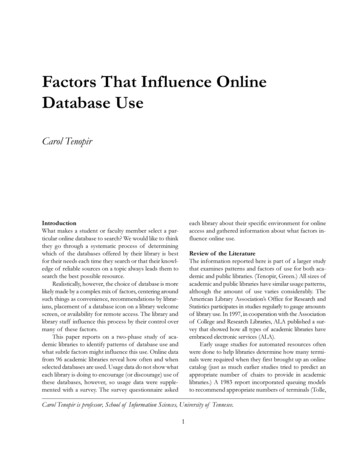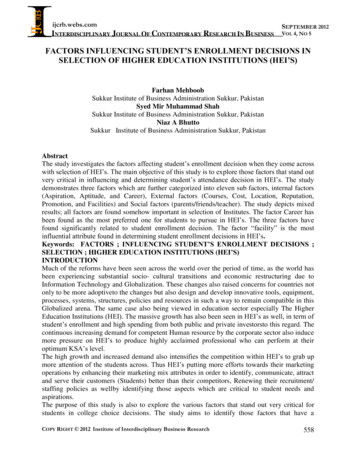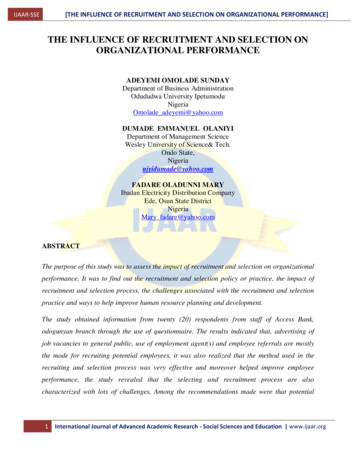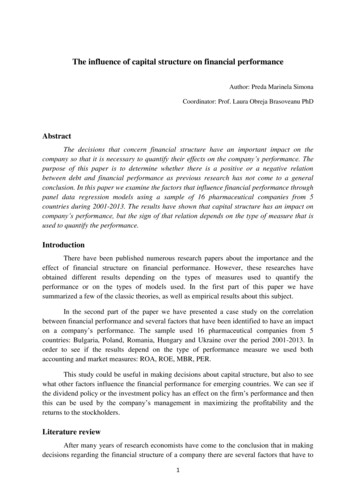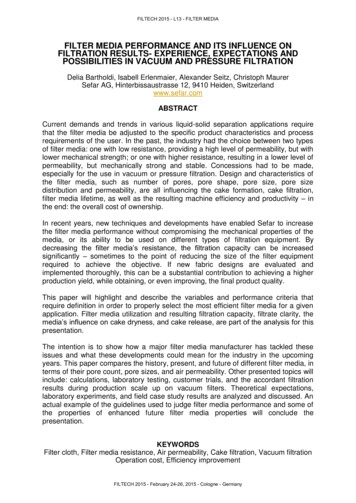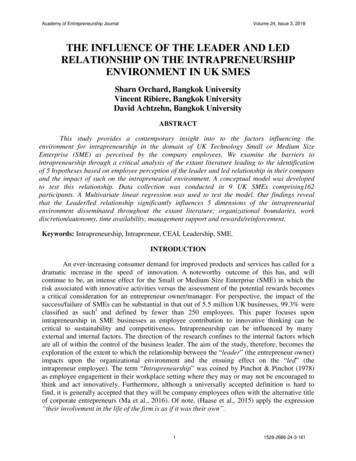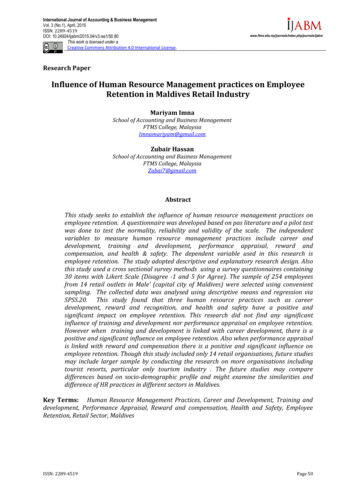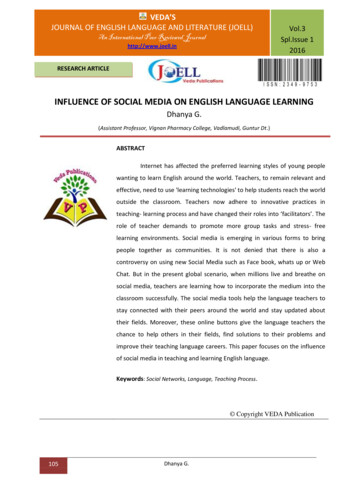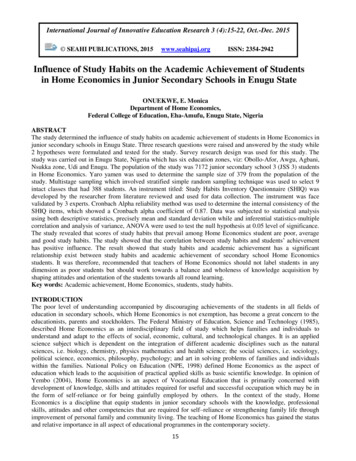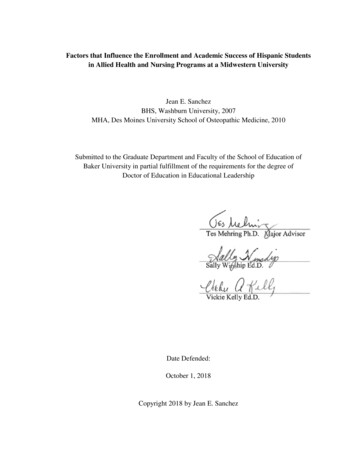
Transcription
Factors that Influence the Enrollment and Academic Success of Hispanic Studentsin Allied Health and Nursing Programs at a Midwestern UniversityJean E. SanchezBHS, Washburn University, 2007MHA, Des Moines University School of Osteopathic Medicine, 2010Submitted to the Graduate Department and Faculty of the School of Education ofBaker University in partial fulfillment of the requirements for the degree ofDoctor of Education in Educational LeadershipDate Defended:October 1, 2018Copyright 2018 by Jean E. Sanchez
AbstractResearch indicates there is a deficit of minority health care providers in theUnited States, which is partially due to limited diversity among applicants to healthsciences programs. Increasing the proportion of minority health providers to moreeffectively reflect the communities served has been identified as a strategy to reducehealth disparities. With the continued growth of the Hispanic population in the UnitedStates along with data indicating there is a direct correlation between lack of culturaldiversity of healthcare employees and health disparities, the number of Hispanic studentsenrolling in nursing and allied health programs needs to be increased.The purpose of this study was to ascertain factors that contribute to enrollmentand academic success of Hispanic Students in allied health and nursing programs. EightHispanic students currently enrolled in or recently graduated from allied health or nursingprograms at Midwestern University were interviewed. Data obtained from the interviewswere analyzed to identify themes. Eight themes emerged including (1) insufficiency ofcollege-going information; (2) affording college; (3) fitting in; (4) support and assistance;(5) work and life balance; (6) intrinsic factors; (7) increasing diversity; and (8) financialaid and scholarships. The findings present potential solutions for colleges as they workto increase the number of Hispanic students enrolled in and graduating from allied healthand nursing programs.ii
DedicationThis dissertation is dedicated to my husband who is the smartest individual I haveever known. While he may not have earned a traditional education, his passion forlearning has motivated me throughout my educational pursuits. I am inspired by hisjourney from Mexico to the United States and his perseverance through incrediblechallenges. Because of his journey I was compelled to complete this research in an effortto help others overcome barriers to the pursuit of their dreams.iii
AcknowledgementsThis journey was made possible by the encouragement and support of manyindividuals. To my husband who has always believed in and supported me, thank you foryour patience while I completed this work. To my family, thank you for yourencouragement and cheerleading every step of the way. Thank you to my colleagues andfriends who offered tips and advice that kept me on the path. Without the inspiration andsupport of Dr. Vickie Kelly, I would not have begun the program at Baker University andthe road to finishing would have been much more difficult if she were not there to keepme going.The support and assistance of faculty and advisors at Baker University wasgreatly appreciated as well. Dr. Tes Mehring, you are an amazing individual and I don’tknow how you always responded to me so quickly. Your positive style motivated me andI know it has been inspirational for many others. Dr. Peg Waterman, you helped me somuch, from really understanding statistics, to learning qualitative research methods, Icannot thank you enough for all you have done. Special thanks to Dr. Sally Winship as itwas during your class and a specific assignment where I made my decision about thetopic of my research. I appreciate all of you for taking the time to read my dissertation,more than once, and for providing thoughtful feedback on each occasion.Finally, thank you to the students who took time out of their busy schedules tomeet with me for interviews. Each of them was gracious as they shared very personalstories. They were all willing to do so in an effort to help future Hispanic students reachtheir goals. I was inspired by all of them and am confident they will realize their dreams.iv
Table of ContentsAbstract . iiDedication . iiiAcknowledgements . ivTable of Contents .vList of Tables . ixChapter 1: Introduction .1Background .1Statement of the Problem .5Purpose of the Study .7Significance of the Study .8Delimitations .9Assumptions.9Research Questions .10Definition of Terms.11Organization of the Study .12Chapter 2: Review of the Literature.13Background Information and Context for the Study.14Health Disparities.15Support for Diversity in the Healthcare Workforce .17Strategies to Promote Diversity in the Healthcare Workforce.20The Deficiency of Hispanic Students in Allied Health and Nursing Programs .26Pursuit of Education by Hispanic Students .26v
Perceived Barriers to Enrollment and Academic Success .29Factors that Contribute to Enrollment and Academic Success .33Successful Programs .38Theoretical Frameworks .43Summary .46Chapter 3: Methods .48Research Design.48Selection of Participants .49Measurement .50Data Collection Procedures.54Analysis and Synthesis of the Data .57Researcher’s Role .59Limitations .60Summary .60Chapter 4: Results .62Descriptive Demographics and Background Information .62Emerging Themes .64Barriers that Inhibit Enrollment in Allied Health or Nursing Programs .64Insufficiency of College-Going Information .64First to Attend College .65Secondary and Post-Secondary Advising .66Affording College .67Factors that Promote Enrollment in Allied Health or Nursing Programs .68vi
Factors that Inhibit Academic Success in Allied Health or Nursing Programs .69Life Experiences .70Living Arrangements .71Factors that Promote Academic Success in Allied Health or Nursing Programs .72Work and Life Balance .75Intrinsic Factors .76Personal Motivation .76Academics .77Time Management .78Solutions for Removing Barriers to Enrollment and Academic Success .79Increasing Diversity .79Financial Aid and Scholarships .81Solutions for Promoting Enrollment and Academic Success .83Education and Outreach .83Improve Accessibility .85Summary .87Chapter 5: Interpretation and Recommendations .88Study Summary.88Overview of the Problem .88Purpose Statement and Research Questions .89Review of the Methodology.89Major Findings .89Findings Related to the Literature.91vii
Barriers Inhibiting Enrollment and Academic Success .91Factors Promoting Enrollment and Academic Success .93Conclusions .95Implications and Suggestions .96Recommendations for Future Research .99Concluding Remarks .100References .102Appendices .113Appendix A. Interview Questions.114Appendix B. Baker University IRB Request .118Appendix C. Baker University IRB Approval .123Appendix D. Midwestern University IRB Request .126Appendix E. Midwestern University IRB Approval.133Appendix F. Approved Consent Statement .135Appendix G. Invitation to Participate Email .137viii
List of TablesTable 1. Percentage of Hispanic Professionals Employed in Allied Health and NursingFields .3ix
1Chapter 1IntroductionDuring the first decade of this century, the Hispanic population in the UnitedStates grew from 15.2 million to 50.5 million individuals, accounting for 16.3% of thetotal population of the United States (Ennis, Rios-Vargas, & Albert, 2011; Reyes & Nora,2012). It has been predicted that these numbers are expected to rise over the next fewdecades, tripling by the year 2050 (Healey, 2013). Unfortunately, the allied health andnursing workforce has not kept pace with the increase in the country’s Hispanicpopulation. In a study conducted by Snyder, Stover, Skillman, and Frogner (2015), itwas determined that 5% of the nation’s registered nurses and approximately 10.9% of theentire healthcare workforce identified as Hispanic. Research has demonstrated thathealth outcomes are improved when there are similarities in ethnic representation ofhealth care providers and the patients served (Healey, 2013). Increasing the numbers ofHispanic students enrolled in health care programs may be one way to improve healthoutcomes in the United States, particularly in communities with high numbers ofHispanic residents. While a few states have identified the need to increase enrollment ofHispanic students, the numbers of Hispanic students enrolled in health care programsacross the nation continues to be low (Cason et al., 2008; Healey, 2013; Reyes & Nora,2012).BackgroundThe numbers of Hispanic citizens have increased significantly, and that growth isexpected to continue (Healey, 2013; Reyes & Nora, 2012). It has been further predictedthat by the year 2080, approximately 51% of United States’ citizens will be minorities
2with the largest sub-population being Hispanic (Healey, 2013). The continued growth ofthe Hispanic population and their access to quality healthcare has been a topic ofincreasing interest over the past several years.In 2005, Fleming, Berkowitz, and Cheadle completed a review of a Robert WoodJohnson Foundation-funded program titled, Cross-Cultural Education in Public Health(CCEPH). In this review, the authors identified several issues ethnic minorities face inthe United States that contribute to disparities, including disproportionate levels ofdisease, higher rates of poverty, lower rates of access to medical care and healthcareeducation, higher mortality rates, and the burdens of discrimination. Burkholder andNash (2014) described the challenges that new immigrants and non-native speakers facewhen attempting to develop social networks. For example, it can be difficult tounderstand where to access care and many individuals do not have communityconnections where resources may be shared. Burkholder and Nash (2014) explained thatstrict immigration policies and fear of retribution can cause some individuals to avoidseeking health care, particularly if they do not identify with the providers. Language andcultural barriers are common in all areas of healthcare. There are often challenges withverbal communication along with differences in the actual definitions of health and wellbeing. It is common for personnel in healthcare institutions to attempt to teach nonSpanish speakers how to speak medical Spanish in order to provide basic treatment topatients. Unfortunately, much can be lost in translation. There also exists the continueddilemma of non-verbal, cultural dissimilarities (Burkholder & Nash, 2014; Fleming et al.,2005).
3Continued growth of the Hispanic population in the United States, along with datadocumenting a direct correlation between the lack of cultural diversity in the healthcareworkplace and health disparities, point to the need for an increase in the numbers ofHispanic students graduating from allied health and nursing programs. In their 2015study, Snyder et al. reported that 5% of registered nurses and approximately 10.9% of theentire healthcare workforce was Hispanic. Additionally, the percentage of Hispanicnurses who graduated with a bachelor’s degree or higher was even lower (Marquand,2014). Table 1 illustrates the percentage of Hispanic professionals employed in a varietyof health occupations, along with the percentage of change within a nine-year time periodbetween 2004 and 2013.Table 1Percentage of Hispanic Professionals Employed in Allied Health and Nursing FieldsHealth Professions Occupation2013Change from 2004Physical Therapists2.8-6.1Occupational Therapists5.10.9Physical Therapist Assistants and Aides9.70.1Occupational Therapy Assistants and Aides3.5-1.5Respiratory Therapists6.52.6Radiation Therapists5.3-13.410.3-0.5Medical and Health Services Managers6.71.8Licensed Practical and Licensed Vocational Nurses8.71.5Registered Nurses5.05.0Diagnostic-Related Technologists and TechniciansNote. Adapted from Healthcare Workforce Data: Hispanic Distribution, by Snyder et al., 2015.Retrieved from PORT kforce 7.8.2015.pdf
4Research has indicated the deficit in minority health care providers in the UnitedStates is partially due to limited diversity among applicants to health sciences programs(Fleming et al., 2005). Increasing the proportion of minority health providers to moreeffectively reflect the communities served has been identified as a strategy to reducehealth disparities (Fleming et al., 2005). To address the deficit of minority healthprofessionals, higher education institutions should place emphasis on increasing thenumber of Hispanic students enrolled in allied health and nursing programs.To understand the broader issues associated with the lack of Hispanic studentsgraduating from allied health and nursing programs, it is also helpful to examine theoverall barriers with regard to the pursuit of post-secondary education. In a paper titled,Lost Among the Data: A Review of Latino First Generation College Students, Reyes andNora (2012) identified several important statistics. First, only 37% of Hispanic highschool graduates between the ages of 18 to 24 were enrolled in two or four-year collegesor universities at the time their study was completed. This compared to their Whitecounterparts with 49% enrolled in post-secondary education. Additionally, only one inten Hispanic adults between the ages of 18 to 24 held a college degree and about “half ofall Latino college students had parents whose highest level of education was a highschool diploma or less” (Reyes & Nora, 2012, p. 2). Data obtained from the UnitedStates Census Bureau for the year 2012 indicated that the number of Hispanic adultsenrolled in two or four-year colleges or universities between the ages of 18-24 hadincreased to 49%, while the number of Wh
in Allied Health and Nursing Programs at a Midwestern University Jean E. Sanchez BHS, Washburn University, 2007 MHA, Des Moines University School of Osteopathic Medicine, 2010 Submitted to the Graduate Department and Faculty of the School of Education of Baker University in
